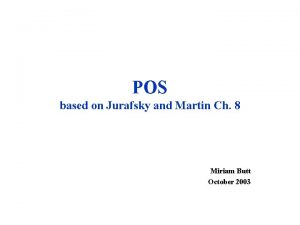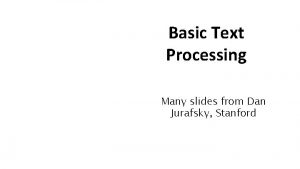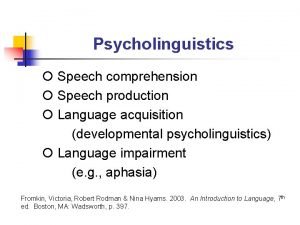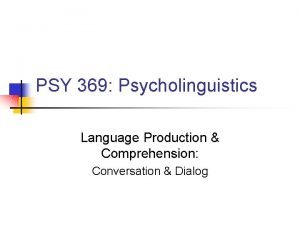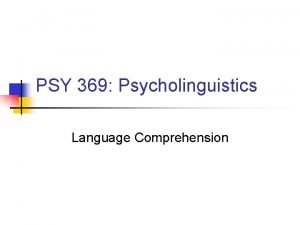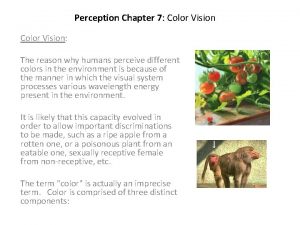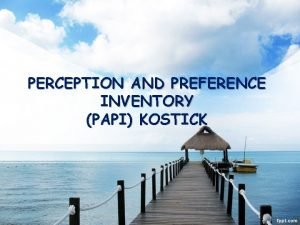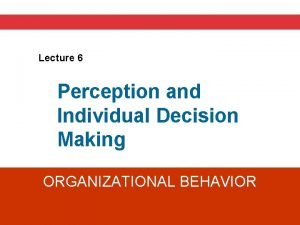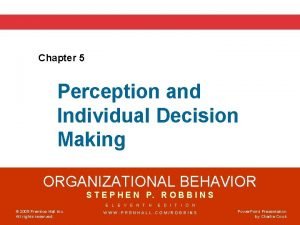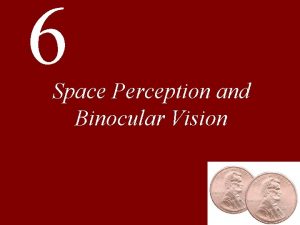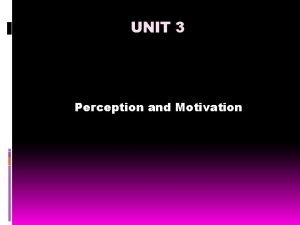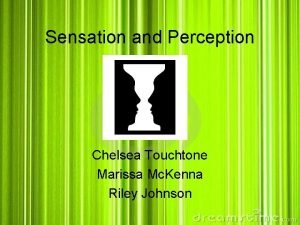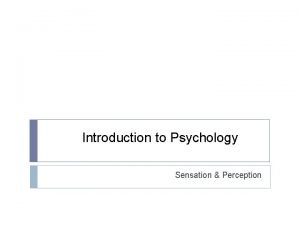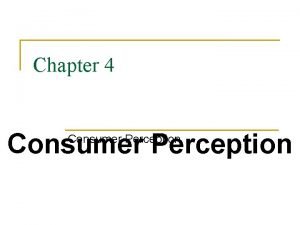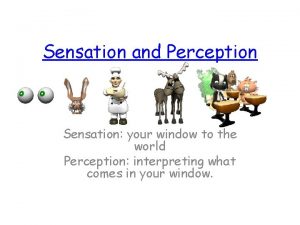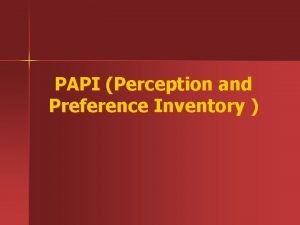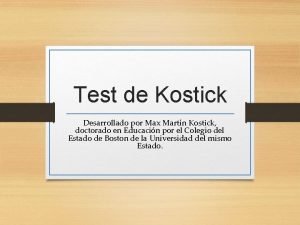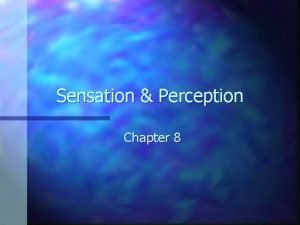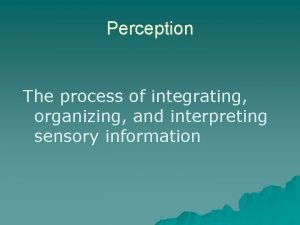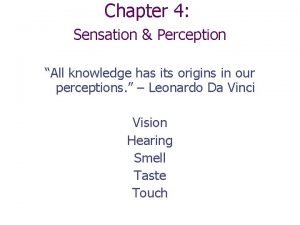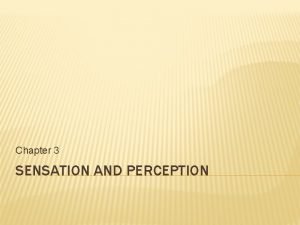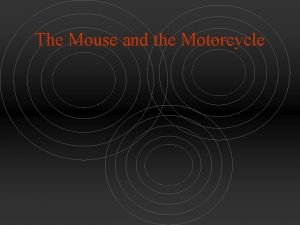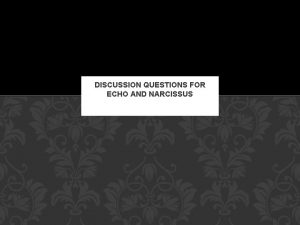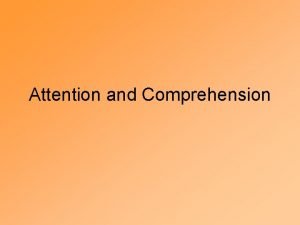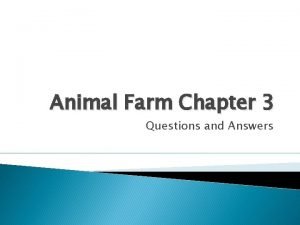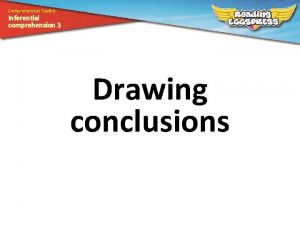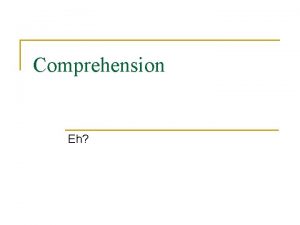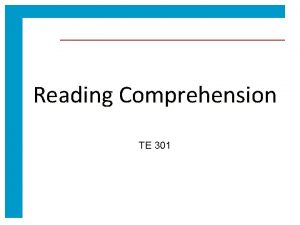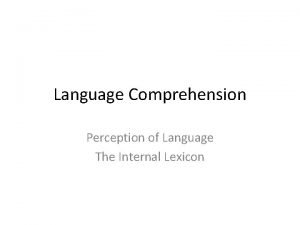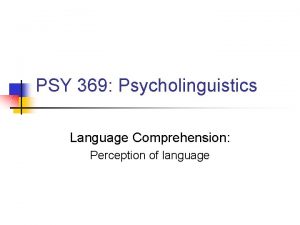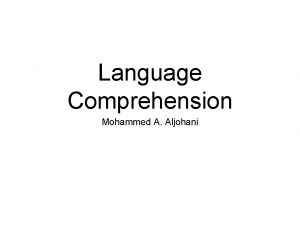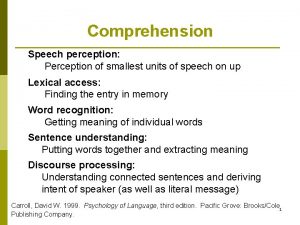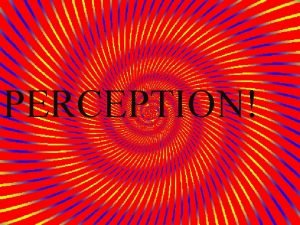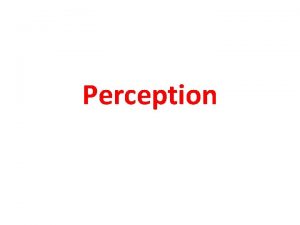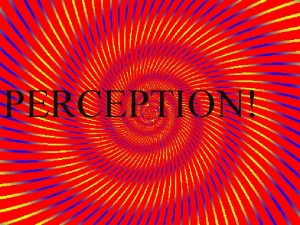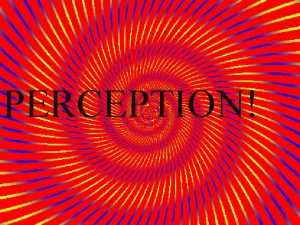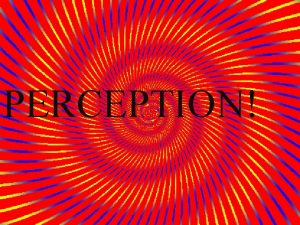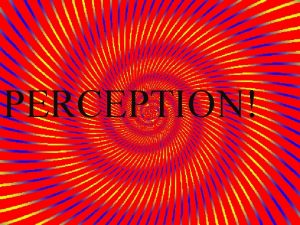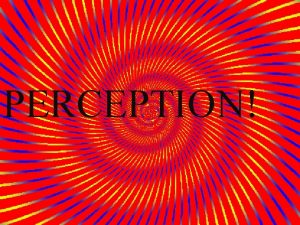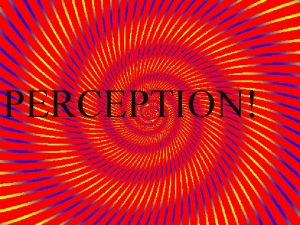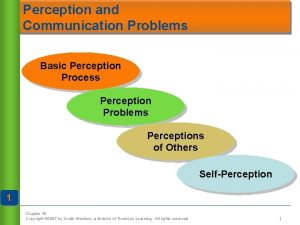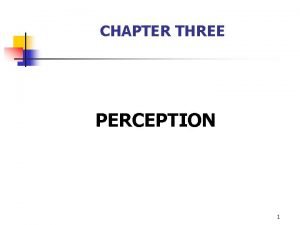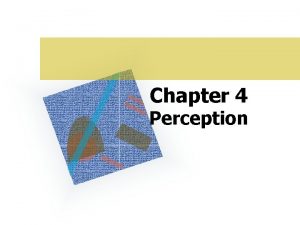Language Perception and Comprehension May 5 2005 Jurafsky













































- Slides: 45

Language Perception and Comprehension May 5, 2005 Jurafsky Symbolic Systems 100, Spring 2005

Outline • Reminder: ambiguity and disambiguation • Recognition of phones – Use of phonetic context – Use of lexical context – Use of visual context • Lexical Access: recognition of words: – Segmentation – Use of visual information – Word sense disambiguation • Jurafsky Ambiguity at higher levels Symbolic Systems 100, Spring 2005

Reminder of Ambiguity (from first day of class) • Find at least 5 meanings of this sentence: – I made her duck Jurafsky Symbolic Systems 100, Spring 2005

Ambiguity • Find at least 5 meanings of this sentence: – I made her duck • • • I cooked waterfowl for her benefit (to eat) I cooked waterfowl belonging to her I created the (plaster? ) duck she owns I caused her to quickly lower head or body I waved my magic wand turned her into undifferentiated waterfowl • At least one other meaning that’s inappropriate for gentle company. Jurafsky Symbolic Systems 100, Spring 2005

Ambiguity is Pervasive • I caused her to quickly lower head or body – Grammar: “duck” can be a noun (waterfowl) or a verb (move body) • I cooked waterfowl belonging to her. – Grammar: “her” can be a possessive (“of her”) or dative (“for her”) pronoun • I made the (plaster) duck statue she owns – Meaning: “make” can mean “create” or “cook” Jurafsky Symbolic Systems 100, Spring 2005

Ambiguity is Pervasive • Grammar: Make can be: – Transitive: (verb has a noun direct object) • I cooked [waterfowl belonging to her] – Ditransitive: (verb has 2 noun objects) • I made [her] (into) [undifferentiated waterfowl] – Action-transitive (verb has a direct object and another verb) • I caused [her] [to move her body] Jurafsky Symbolic Systems 100, Spring 2005

Ambiguity is Pervasive • Phonetics! – – – – – Jurafsky I mate or duck I’m eight or duck Eye maid; her duck Aye mate, her duck I maid her duck I’m aid her duck I mate her duck I’m ate or duck I mate or duck Symbolic Systems 100, Spring 2005

Syntactic Ambiguity • Grammar: – “The other day I shot an elephant in my pajamas (what he was doing in pajamas I’ll never know)” – Groucho Mark – What’s the ambiguity? • “In my pajamas” can modify “I” or “elephant” Jurafsky Symbolic Systems 100, Spring 2005

What we’ve learned • Ambiguity is pervasive – Phonetics – Segmentation – Word part of speech – Word meaning – Syntactic properties Jurafsky Symbolic Systems 100, Spring 2005

How do we deal with ambiguity? Jurafsky Symbolic Systems 100, Spring 2005

Language processing is fast • • Shadowing task -Marslen-Wilson (1975) Some subjects can close-shadow Can shadow at latencies of 250 -275 ms Less 50 -75 ms for response execution – So ~200 ms to identify a word – Before acoustic offset of word! • Furthermore, shadowers in this time can correct errors. Symbolic in pronunciation or grammar! Jurafsky Systems 100, Spring 2005

What we’ve learned • Language perception is very fast Jurafsky Symbolic Systems 100, Spring 2005

Speech perception • • • Words are made up of units called “phones” “duck”: [d ah k] “eat”: [iy t] “made”: [m ey d] “her”: [h er] “I”: [ay] “symbolic” [s ih m b aa l ih k] “systems” [s ih s t em z] English has about 50 (some lgs have less, some Jurafsky Symbolic Systems 100, Spring 2005 more)

Phone perception • People hear sound waves • How are they able to recognize words in the input? • Assumption: first they recognize the phones that make up the words • How does phone perception work? Jurafsky Symbolic Systems 100, Spring 2005

Phone perception is difficult • Different people have different accents • People talk fast or slow • Many phones sound alike, are hard to tell apart • Most important issue: context Jurafsky Symbolic Systems 100, Spring 2005

Phones are context-dependent • http: //www. fon. hum. uva. nl/praat/ Jurafsky Symbolic Systems 100, Spring 2005

Phones are context-dependent Jurafsky Symbolic Systems 100, Spring 2005

Warren (1970) • The state governors met with their respective legislatures convening in the capital city Jurafsky Symbolic Systems 100, Spring 2005

Warren (1970): Phoneme Restoration Effect • The state governors met with their respective legislatures convening in the capital city • The /s/ was deleted in “Legi*latures” and replaced with a cough. • Warren found participants – Heard the word normally – Only one participant reported a missing phoneme – (But reported the wrong one!) • Knowledge about likely spoken word can “fill in” missing phoneme information Jurafsky Symbolic Systems 100, Spring 2005

Warren (1970): Phoneme Restoration Effect 1) 2) 3) 4) • The *eel was on the axle. The *eel was on the shoe. The *eel was on the orange. The *eel was on the table. Listeners reported hearing 1) 2) 3) 4) Jurafsky Wheel Heel Peel Meal Symbolic Systems 100, Spring 2005

Mc. Gurk Effect Jurafsky Symbolic Systems 100, Spring 2005 http: //www. media. uio. no/personer/arntm/Mc. Gurk_english. html

Mc. Gurk Effect: an Auditory Illusion • Visual cues to syllable“ga” • Auditory cues to syllable “ba” • Results in perception of “da” or “tha” Jurafsky Symbolic Systems 100, Spring 2005

What we’ve learned • Phone perception relies on knowledge at different levels to solve problem of ambiguous input. – Phonetic context – Lexical context – Visual context Jurafsky Symbolic Systems 100, Spring 2005

Lexical Access: Detection/Recognition of words • Segmenting words in speech • Use of visual information in word search • Speed of disambiguation process Jurafsky Symbolic Systems 100, Spring 2005

Lexical Access: segmentation • Speech doesn’t come with spaces in it – The stuffy nose can lead to trouble – The stuff he knows can lead to trouble – Some others I’ve seen – Some mothers I’ve seen Jurafsky Symbolic Systems 100, Spring 2005

Word segmentation: experiment • Shillcock (1990) • “Cross-modal priming” experiment – Based on “lexical decision” (LD) task Jurafsky Symbolic Systems 100, Spring 2005

Lexical Decision • • Subjects at computer 2 buttons, YES and NO See strings of letters on screen Have to decide “are these a word or not”? – DOCTOR - yes – DOCPOR - no – THINK - yes – THIFF - no Jurafsky Symbolic Systems 100, Spring 2005

Lexical Decision of “FLINK” Jurafsky Symbolic Systems 100, Spring 2005 http: //ibs. derby. ac. uk/~kpat/Israel_cognitive/button 1. jpg

Lexical Decision • Facts about Lexical Decision – More frequent words are recognized faster – Shorter words are recognized faster – Semantic Priming: • NURSE • DOCTOR Faster to recognize DOCTOR than • PURSE • DOCTOR – So something about the meaning of NURSE “primes” the recognition of DOCTOR Jurafsky Symbolic Systems 100, Spring 2005

Shillcock (1990) Cross-Modal Priming • • Subjects hear a sentence over a headphone. At some point in the sentence, subjects see a word on screen and have to do LD 1) The scientist made a new discovery last year. 2) The scientist made a novel discovery last year • • Lexical decision to NUDIST Subjects were primed in (1) but not in (2) Idea: speakers first mis-segmented “new dis” as NUDIST But speakers were not aware of having done this Jurafsky Symbolic Systems 100, Spring 2005

What we’ve learned • Word recognition in speech is parallel • Multiple possible segmentations are considered and rejected subconsciously and quickly Jurafsky Symbolic Systems 100, Spring 2005

Use of visual information in lexical access Jurafsky Symbolic Systems 100, Spring 2005

Eye tracking example Jurafsky Symbolic Systems 100, Spring 2005

The candle/candy task Jurafsky Symbolic Systems 100, Spring 2005

Jurafsky Symbolic Systems 100, Spring 2005

“Pick up the candy” Jurafsky Symbolic Systems 100, Spring 2005 Tanenhaus et al

Word Recognition • Word recognition is incremental – Before the end of the word is spoken, eye movements are launhced to possible targets • Millisecond by millisecond, information from the visual environment is used in the process of word recognition. – Word recognition is fatser when there are no competitors visible Jurafsky Symbolic Systems 100, Spring 2005

Word sense disambiguation • Words can have two meanings – “bug” • Recording device • Insecty thing • Also called “lexical ambiguity” or “word sense ambiguity” • How do people resolve lexical ambiguity? Jurafsky Symbolic Systems 100, Spring 2005

Swinney (1979) • Rumor has it that, for years, the government building had been plagued with problems. The man was not surprised when he found several spiders, roaches, and other bugs (1) in the corner (2) of his room. " • Immedidately at (1), which sense of the word “bug” is active? – – Jurafsky Insect Recording device Both Neither Symbolic Systems 100, Spring 2005

Swinney (1979) • Rumor has it that, for years, the government building had been plagued with problems. The man was not surprised when he found several spiders, roaches, and other bugs (1) in the corner (2) of his room. " • Cross-Modal Priming • Test words – ANT (appropriate for the context) – SPY (not appropriate, but related to the other meaning of bugs) – SEW (unrelated control word) Jurafsky Symbolic Systems 100, Spring 2005

Swinney (1979) Results • Immediately: facilitation of both – ANT (appropriate for the context) – SPY (not appropriate, but related to the other meaning of bugs) • when compared to – SEW (unrelated control word) • By 750 millisec later (other studies showed 200 ms) only find facilitation for ANT • Idea: parallel activation of all meanings, they compete, by about 200 ms later, only the correct one is still active, it’s then available to consciousness Jurafsky Symbolic Systems 100, Spring 2005

What we’ve learned • Word meaning recognition is also parallel • Lots of contextual information is used (very quickly but perhaps not immediately) to resolve lexical ambiguities Jurafsky Symbolic Systems 100, Spring 2005

Conversational meaning • Words mean things • Consciously we know that • But even when we’re not conscious they still mean things • Conversational disambiguation Jurafsky Symbolic Systems 100, Spring 2005

Discourse disambiguation • We can use sentences in a conversation for different purposes – – – Question Command Statement Agreement Disagreement • These are called “speech acts” • Speech act ambiguity: Jurafsky Symbolic Systems 100, Spring 2005

Conclusion • Language is highly ambiguous – – – Phone detection (Warren, “stamp”) Word segmentation (Shillcock) Word semantics (Swinney) Grammar (duck) Pragmatics (Who’s on first) • Humans resolve by: – consider each interpretation of an ambiguity, – combine visual, lexical, phonetic knowledge/context to choose most likely meaning, – subconsciously • Current research: what knowledge sources, how learned, how represented, how combined Jurafsky Symbolic Systems 100, Spring 2005
 Jurafsky & martin
Jurafsky & martin Dan jurafsky nlp
Dan jurafsky nlp Dan jurafsky nlp slides
Dan jurafsky nlp slides Comprehension and production in language acquisition
Comprehension and production in language acquisition Language comprehension
Language comprehension Cratily
Cratily Hci patterns
Hci patterns Chapter 5 sensation and perception
Chapter 5 sensation and perception Chapter 7 vision and perception
Chapter 7 vision and perception Preference inventory
Preference inventory Perception and individual decision making
Perception and individual decision making Gestalt reversible figures
Gestalt reversible figures Eudemonistic model of health
Eudemonistic model of health Perception and decision making in organizational behavior
Perception and decision making in organizational behavior Subjective perception of vitality and feeling well
Subjective perception of vitality and feeling well Relative height ap psychology
Relative height ap psychology Binocular disparity
Binocular disparity Motivation and perception
Motivation and perception Difference between sensation and perception
Difference between sensation and perception Perception
Perception Chapter 3 sensation and perception
Chapter 3 sensation and perception Sensation and perception
Sensation and perception Chapter 6 sensation and perception
Chapter 6 sensation and perception Copyright
Copyright Sensation and perception in marketing
Sensation and perception in marketing Sensation and perception
Sensation and perception Sensation and perception
Sensation and perception Kinesthesis and vestibular sense
Kinesthesis and vestibular sense Perception and preference inventory
Perception and preference inventory Kostick prueba
Kostick prueba Chapter 8 sensation and perception
Chapter 8 sensation and perception Chemical substance that alters perceptions and mood
Chemical substance that alters perceptions and mood Sensation and perception uu
Sensation and perception uu Chapter 7 managing risk vision and perception
Chapter 7 managing risk vision and perception Chapter 4 sensation and perception
Chapter 4 sensation and perception Chapter 3 sensation and perception
Chapter 3 sensation and perception Steps in counseling process
Steps in counseling process Clean neighbourhoods and environment act 2005 dog fouling
Clean neighbourhoods and environment act 2005 dog fouling The vocabulary of an index language may be
The vocabulary of an index language may be Unit 1 jobs
Unit 1 jobs The mouse and the motorcycle chapter 1 questions
The mouse and the motorcycle chapter 1 questions Pan-african movement stamp
Pan-african movement stamp Echo and narcissus comprehension questions
Echo and narcissus comprehension questions Attention and comprehension
Attention and comprehension Animal farm chapter 3 questions answer key
Animal farm chapter 3 questions answer key Walk two moons test
Walk two moons test
